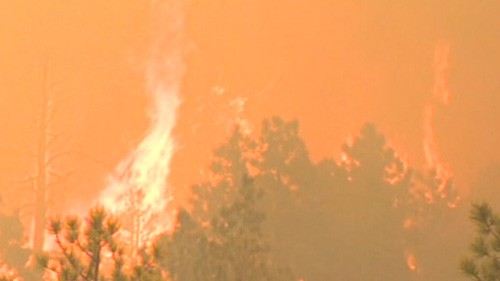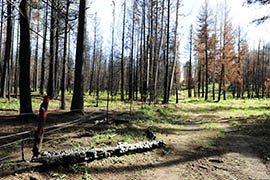Cronkite News has moved to a new home at cronkitenews.azpbs.org. Use this site to search archives from 2011 to May 2015. You can search the new site for current stories.
Study: Climate change will make wildfires worse for Arizona, nation
PHOENIX – While Arizona’s most recent fire season was relatively tame, one study argues that the worst may be yet to come due to climate change.
In a study titled “Flammable Planet: Wildfires and the Social Cost of Carbon,” the Cost of Carbon Pollution project predicts larger, more frequent, more intense and more costly wildfires around the world by 2050 – with the American Southwest being affected in particular.
Using current projections for warming temperatures and other factors, the study puts a price tag on the increased wildfire threat.
“The United States will be particularly affected; scientists predict a 50 to 100 percent increase in area burned by 2050,” the study reads.
Dr. Peter Howard, author of the study and economic fellow at the Institute of Policy Integrity at New York University’s School of Law, said that the increase would disproportionately affect the western United States, including Arizona.
“Clearly fires are going to increase in severity, and the western United States is already a high-risk area,” Howard said.
The Cost of Carbon Pollution project is a joint effort between the Institute for Policy Integrity at New York University’s School of Law, the Environmental Defense Fund and National Resources Defense Council. The project is designed to measure the financial impact of climate change, focusing particularly on unseen costs that might not be immediately associated with climate science.
“This study is attempting to get people to say ‘Look, these costs are significant,’” Howard said. “We really need a lot more research in this field.”
Howard identified the indirect health consequences of wildfires, such as asthma and cardiovascular disorders caused by smoke, as major costs that go underreported. Additionally, Howard said, lost tax revenue and tourism dollars that would have been spent on forests dwarf the costs of fire suppression.
The study estimates the total annual cost of U.S. wildfires at between $20 billion and $125 billion. Howard said that increased wildfires could add as much as $60 billion to those estimates.
The issues are felt acutely in Arizona, where national forests cover 15 percent of the state’s land. Additionally, Arizona has seen its population more than double since 1980, with more increases projected for the state.
Howard said that having more people in forested areas adds to the risk.
“It also changes the way that we fight fires if firefighters feel that human lives or property are at risk,” he said.
Much of the impact has less to do with the number of wildfires in a given year but rather the number of large wildfires. Arizona has seen five wildfires burn more than 100,000 acres since 2000.
Wally Covington, regents professor at Northern Arizona University’s School of Forestry, said that these developments are just the beginning, and it could have drastic consequences for Arizona’s environment.
“Arizona is the unfortunate leader in larger fires,” Covington said. “Forestry officials know that the state is in peril.”
In addition to the economic impacts above, Covington pointed to social costs, including harm to water supplies that range from ash in drinking water to increased flooding as watersheds lose the vegetation they need to flourish.
Covington said that watersheds with dead or dying plants are more susceptible to fires, adding that encouraging proper watershed growth could go a long way toward managing the damage caused by wildfires.
Jennifer Jones, public affairs specialist for the National Interagency Fire Center, said that agencies can do more to prepare for wildfires and have implemented a plan focused around three key elements: cooperative response, landscape restoration and making communities more fire-adaptive.
“Generally, the Forest Service concurs with the consensus and believes that fires will continue to get bigger,” Jones said. “And we need to be prepared.”
According to Jones, cooperative response involves helping forest officials coordinate more effectively with local firefighters in order to better utilize trucks, planes and other tools. Meanwhile, restoration creates landscapes that are less likely to induce severe wildfires, using techniques like mechanical thinning of forests and controlled burns to remove flammable underbrush.
“There’s generally pretty widespread agreement that forests have more fuel than is desired, and something needs to be done about that,” Jones said.
Finally, forestry divisions are working with local communities to come up with fire-adaptive programs designed to limit fire risks in cities and counties. 27 communities across Arizona have adopted Community Wildfire Protection Plans with the Arizona State Forestry Division.
“There are 70,000 communities at risk from fire damage, and just 15,000 have large-scale fire plans in place,” Jones said.
While these programs vary from community to community, they generally involve having individuals maintain the vegetation on their property and making sure that communities know what resources are available to them.
Covington said that any sort of success at fighting wildfires will require communities and agencies alike to begin spending more money to address the problem.
“Everyone wants to contribute, but no one wants to be the first,” he said.









